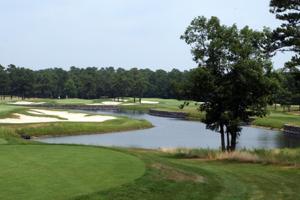Ballamor’s past proves to be a benefit to its present

Ballamor Golf Club once struggled for notoriety after it changed
from private to public play. Now its past may be a benefit, according to Mike
Jackson, the club's new general manager.
“Unlike other public courses that were built for that purpose, we
were initially a private, Parkland-style course built into the woods,” he says
of the Egg Harbor Township facility. “There are no homes. You go into the woods
and you never come out, until you are done. It's very peaceful for a golfer.”
Ballamor became public a few years back and was later purchased by
the Ottinger Golf Group, which owns Atlantic City Country Club in Northfield
and Scotland Run in Williamstown. All three courses are available in membership
form. Otherwise, the public can play here for summer rates usually set between
$70 to $109.
Ballamor offers five sets of tees ranging from 7,098 yards — the
equivalent of a professional tournament — to 5,238 yards. It is loaded with
long par-5's, including a whopping 625-yard layout on the fifth hole's back
tees. Even from the mid tees, it's a formidable 551-yard challenge and
considered the hardest hole on the course. This is a dogleg left par-5 that
requires a strong drive to nestle between two fairway traps, a low iron or
hybrid, then a high iron to a large green. Getting one's third shot close to
the pin on this long hole will be tricky.
Eighteen is Jackson's favorite hole, for varied reasons. It's a
strong finishing layout, sweeping gradually to the right in the form of a
par-5, 480 yards from the mid tees. Jackson also has notched two eagles on this
hole. “It’s an excellent risk-reward proposition,” he says. “You can get there
in two if you hit two tremendous shots into the green.”
Players can flirt with right-side water and try to hug the edge of
the fairway with their drive, cutting off yardage to the green. Or they can
maneuver safely into the center or left side of the fairway. If opting for the
green in two, their second shot must be accurate. If it drifts right, it will
likely find water or the stone wall that guards the putting surface. Jackson
considers 16 deceivingly difficult. It looks easy enough at 400 yards from the
middle tees, with little sand or water to navigate. The challenge unfolds
closer to the hole, as a slight incline pushes the ball away from the green,
right or left. This green won't accommodate a bump-and-run shot to let the ball
roll on. The approach shot must land on the green and stay, prompting the need
for an accurate high iron.
The third hole also plays harder than it looks. The challenge
appears simple as a 286-yard par-4, but five large bunkers jut out near the
green and in landing areas. The hole bends to the right. If the flag is
positioned right, the second shot must clear water, a stone wall and steer
clear of two large traps. It is a creative layout. The bunkers and water make
up for the short distance, the terrain bends toward the water and pin
placements can increase the difficulty. Jackson, a long hitter off the tee,
nonetheless suggests two irons into this green.
The 10th hole, conversely, looks harder than it plays. “You are on
an elevated tee and you see all these bunkers, a well as the fairway sloping,
up, down and then up again,” Jackson says. “It looks intimidating but what you
have to remember is that there is a wide landing area. You can almost land a
small plane in there,” he jokes. Players can land their small plane, or drive,
almost anywhere, hit a safe second shot into the center of the fairway and a
high iron into the green.

No comments:
Post a Comment